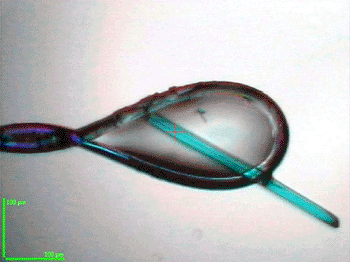New Fluorescent Protein Improves Sensitivity of Cellular Imaging
By LabMedica International staff writers
Posted on 26 Mar 2012
The sensitivity of high-resolution live cell imaging has now been much improved by mTurquoise2, a newly designed variant protein that emits turquoise light more efficiently than the popular, but only modestly bright, Enhanced Cyan Fluorescent Protein (ECFP).Posted on 26 Mar 2012
Cyan Fluorescent Proteins (CFPs) have long suffered from a weak fluorescence level, generally converting merely 36% of the incoming blue into cyan light. In a study published on March 20, 2012, in the journal Nature Communications, scientists developed and applied a highly specialized strategy involving rationalized, stepwise improvements on ECFP, itself an improved, cyan color variant of Green Fluorescent Protein originally cloned from Aequorea victoria.

Image: A tiny crystal of mTurquoise2 viewed with a microscope. mTurquoise2 crystals were used to study the atomic scale interactions that result in its high fluorescence efficiency. (Photo courtesy of CNRS-ESRF/von Stetten/Royant).
As the first step toward achieving the higher brightness and with it improved sensitivity for fluorescent imaging, highly brilliant X-ray beams were used to uncovered subtle details of how CFPs store incoming energy and retransmit it as fluorescent light: they produced tiny crystals of many different improved CFPs and resolved their molecular structures. These structures revealed a subtle process near the so-called chromophore, the light-emitting complex inside the CFPs, whose fluorescence efficiency could be modulated by the environment.
“We could understand the function of individual atoms within CFPs and pinpoint the part of the molecule that needed to be modified to increase the fluorescence yield,” says David von Stetten from the team at the European Synchrotron Radiation Facility (ESRF) (Grenoble, France).
In parallel to this work, the team at the van Leeuwenhoek Center for Advanced Microscopy, University of Amsterdam (The Netherlands) used an innovative screening technique to study hundreds of modified CFP molecules, measuring their fluorescence lifetimes under the microscope to identify which had improved properties.
The result of this rational design is the new CFP named mTurquoise2. By combining structural and cellular biology efforts, the researchers showed that mTurquoise2 has a fluorescence efficiency of 93%, unmatched for monomeric fluorescent proteins. The properties of mTurquoise2 makes it the preferable cyan variant of green fluorescent protein for long-term imaging and as donor for Förster resonance energy transfer to a yellow fluorescent protein.
Related Links:
European Synchrotron Radiation Facility (ESRF)
University of Amsterdam
University Joseph-Fourier














